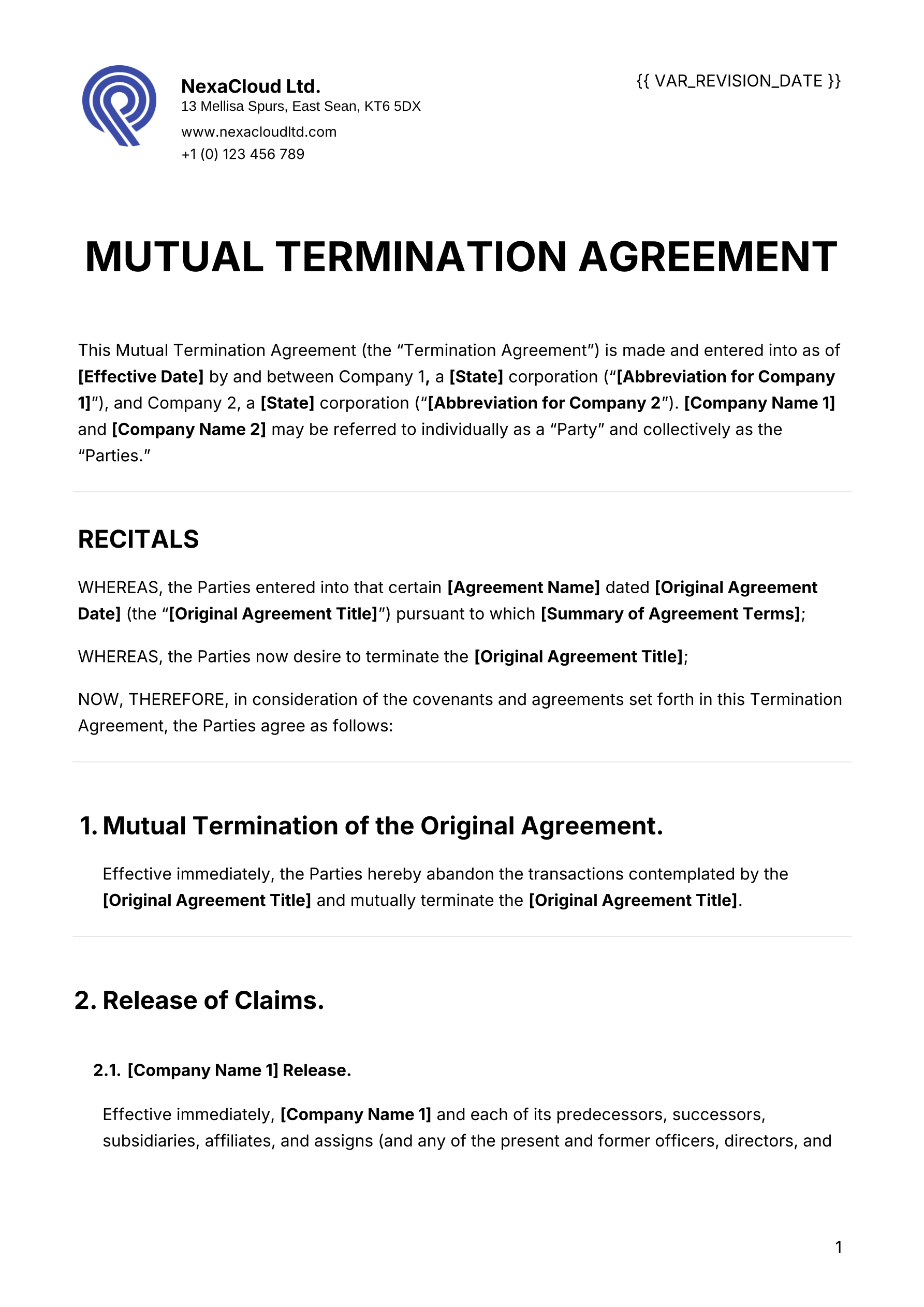How to Terminate a Contract? (Without Bleeding)
Ending a contract isn’t always a walk in the park. Without clear termination terms, things can get messy fast. Disputes pop up, legal battles get expensive, and both businesses and individuals can find themselves stuck in frustrating situations when there’s no clear exit strategy. That’s why the termination clause is one of the necessary and most used clauses in all contracts. These handy provisions explain when and how an agreement can end. They define rights, penalties, and procedures, making sure no one’s left guessing when it’s time to part ways. In this post, we’ll break down the legal grounds for contract termination, walk through the termination process, explore potential consequences, and share best practices for managing contract exits smoothly. Let’s dive in!

Legal Options to Terminate a Contract?
When a contract isn’t holding up its end of the bargain, knowing your legal exit options is key. You can walk away if there’s a major breach if both parties agree to call it quits, or if unforeseen events make fulfilling the contract impossible. Generally speaking, there are 4 possible valid reasons to walk away from a contract, without much bleeding:
1. Termination for Cause
Termination for cause happens when one party pulls the plug on a contract due to the other’s significant failure to meet essential obligations, like a material breach. This kind of breach strikes at the heart of the agreement, giving the non-breaching party solid grounds to walk away. Take a supplier who repeatedly fails to deliver goods as promised—at that point, the buyer has every reason to terminate the contract for cause.
Terminating a contract for a major breach can have serious consequences. The breaching party might be liable for damages, covering both direct losses and any ripple effects. Plus, ending a contract this way can strain business relationships and hurt reputations.
2. Termination at Will
Termination at will lets you end a contract without needing a specific reason—so long as you follow legal and contractual obligations. While most common in employment agreements, it also applies to service contracts, business partnerships, and leases. The upside? Flexibility. The catch? You may still need to honor notice periods or compensation clauses spelled out in the contract. Plus, laws prevent at-will termination from being used for discriminatory or retaliatory reasons.
💡Good to Know: Termination at Will vs. Without Cause. They might sound alike, but termination at will and termination without cause aren’t always the same. Termination at will means you can walk away at any time, for any reason (or none at all). Termination without cause, on the other hand, refers specifically to ending a contract when the other party hasn’t done anything wrong—but it often requires advance notice or severance. At-will termination is usually more immediate, while termination without cause may come with strings attached.
3. Termination for Convenience (T4C)
Sometimes, sticking with a contract just doesn’t make sense—maybe your budget’s tight, priorities have shifted, or your business is restructuring. When there’s no breach, termination for convenience gives you a legal way out.
But walking away without cause isn’t always simple. You’ll need to follow the contract’s rules, like giving proper notice and possibly compensating the other party. Skip these steps, and you could face legal claims for wrongful termination.
🔦 Legal Spotlight: In Torncello v. United States, the U.S. Court of Claims tackled the misuse of the termination for convenience clause. The government had contracted for pest control services but later decided to cut costs by using in-house staff instead. Rather than honoring the agreement, they terminated it for convenience—without ever using the contractor’s services. The court concluded that employing the termination for convenience clause in this manner, to avoid contractual obligations, rendered the contract illusory and was improper. The court rejected this approach. It ruled that this kind of maneuver—using the termination clause to dodge contractual obligations—essentially made the contract illusory and was improper.
4. Mutual Termination of the Agreement
Contracts don’t just end because of breaches or external factors—they can also be mutually terminated when both parties agree to walk away. No drama, no disputes—just a clean break. This happens when a contract no longer serves its purpose, business goals shift, or unexpected circumstances pop up. To keep things smooth, both sides usually sign a mutual termination agreement, covering:
- Why the contract is ending
- How many remaining obligations will be settled
- A waiverof future claims to prevent legal issues down the road
- Understanding termination without cause.
5. Frustration and Impossibility
Contracts assume that certain conditions will stay the same—but life doesn’t always cooperate. Unexpected events like natural disasters or sudden legal changes can throw a wrench into agreements, making it difficult (or even impossible) to fulfill obligations.
That’s where the doctrines of frustration and impossibility come in. If an unforeseen event makes a performance truly impossible, the doctrine of impossibility can release both parties from their obligations. On the other hand, if an event undermines the contract’s core purpose but doesn’t make performance outright impossible, the doctrine of frustration may apply instead.
🔦 Legal Spotlight: The doctrine of impossibility in contract law traces back to the landmark case Taylor v. Caldwell (1863). In this case, a music hall burned down before a scheduled concert, making performance literally impossible. The court ruled that since the contract relied on the hall’s existence, its destruction meant neither party was liable for failing to perform. This decision laid the foundation for the doctrine of impossibility, which still protects parties today when unforeseen events make fulfilling a contract truly impossible.
How to Terminate a Contract — The Safe Way
As one of the most negotiated terms in contracts, having a structured approach for the termination clause helps you stay compliant, reduce disputes, and maintain business relationships. Here’s what you need to know.
1. Reviewing Contract Terms
Before pulling the plug, take a deep dive into the contract. Understanding the termination clauses ensures you’re following the rules and protecting yourself from legal backlash.
Key Steps:
- Locate the Termination Clause – Most contracts outline when and how termination is allowed, including required notice periods and acceptable reasons.
- Assess Grounds for Termination – Are you terminating for cause (due to a breach) or for convenience (without a specific breach)? This distinction matters.
- Evaluate Notice Requirements – The contract likely dictates how much notice is needed and how it must be delivered (e.g., certified mail, email, or in person).
2. Providing Notice of Termination
Once you’ve confirmed termination is the best path, the next step is delivering a formal notice. This isn’t just a formality—it’s a legal requirement that spells out the details of the termination and helps prevent future disputes.
Example of Notice of Termination
Subject: Notice of Mutual Termination of Employment
Dear [Employee’s Name],
This letter serves as formal notice that [Company Name] and [Employee Name] have mutually agreed to terminate your employment, effective [Termination Date].
1. Termination of Employment
As of the termination date, all responsibilities and obligations related to your employment with [Company Name] shall be concluded. Any company property in your possession must be returned by this date.
2. Final Compensation and Benefits
You will receive your final paycheck, including any outstanding wages, unused vacation days, or other applicable benefits as per company policy. Details regarding continuation or termination of any benefits will be provided separately.
3. Confidentiality and Non-Disparagement
You agree to maintain the confidentiality of any sensitive company information and to refrain from making any negative or disparaging statements about the company, its employees, or clients.
4. Release of Claims
Both parties mutually release and discharge each other from any claims or disputes arising from the employment period, except as required by law.
5. Governing Law
This termination agreement shall be governed by and interpreted in accordance with the laws of [State/Country].
Please sign below to acknowledge and agree to the terms of this mutual termination.
Sincerely,
[Company Name]
By: _________________________
Name: [Authorized Representative]
Title: [Job Title]
Date: [Date]
[Employee Name]
By: _________________________
Name: [Employee Name]
Date: [Date]
Best Practices for Termination Notices:
- Be Clear and Concise – Explicitly state your intention to terminate and reference the specific contract clause that allows for it.
- Include Essential Details – Specify the termination date and any final steps required from either party.
- Maintain a Professional Tone – Even in tense situations, keeping the communication neutral and professional helps avoid unnecessary conflict.
- Follow Contractual & Legal Requirements – Some contracts specify how notices should be delivered (e.g., via registered mail or email). Ignoring these details could make the termination invalid.
Many businesses assume termination is simple—until they end up in legal trouble. Disputes over termination notices can lead to huge legal costs and operational delays.
✨ Pro Tip: Look for alternative dispute resolution (ADR) before terminating a contract. Mediation or negotiation can sometimes resolve conflicts without the need for termination, saving both time and money.
3. Ensuring Compliance with Legal Requirements
Legal compliance is always an essential part of any legal procedure. Failing to follow jurisdiction-specific rules can lead to financial penalties, reputational damage, and lawsuits.
To stay compliance, make sure to follow these steps:
- Consult Legal Counsel – Contract termination laws vary by region and industry, so getting expert advice is always a smart move.
- Follow Industry-Specific Regulations – Certain contracts (like employment or government contracts) have strict rules about termination procedures.
- Document Everything – Keep detailed records of termination notices, responses, and final settlements. If a dispute arises, solid documentation can protect you.
Potential Consequences of Contract Termination: What You Need to Know
Whether you’re ending an agreement due to a breach, financial constraints, or shifting priorities, termination can bring a range of financial, legal, and business consequences. Here’s what to watch out for.
Financial Implications: The Cost of Calling It Quits
Terminating a contract can hit your wallet hard, depending on the terms outlined in the agreement. One of the biggest concerns? Damages and compensation. If you’re the non-breaching party, you may be entitled to recover losses—including unpaid invoices, lost profits, or even reputational harm.
Then there’s liquidated damages—pre-agreed compensation amounts baked into the contract. If your agreement includes these clauses, you (or the other party) could be on the hook for a set penalty, regardless of actual financial harm. On top of that, termination might also lead to refunds, penalties, or reimbursements for work already completed.
Bottom line: Before pulling the trigger on termination, take a careful look at your contract to understand the financial risks involved.
Legal Disputes & Litigation: The Risk of Ending Up in Court
Not everyone takes contract termination well—especially if they don’t agree with your reasoning. Disputes can arise over wrongful termination, breach of contract, or failure to meet obligations. If the termination terms aren’t crystal clear, the other party might seek legal recourse, leading to arbitration, mediation, or even a full-blown lawsuit.
And let’s not forget about confidentiality or non-compete clauses. These could limit your ability to enter new agreements after termination, adding another layer of complexity. Since legal battles can be costly and time-consuming, clear termination clauses and dispute resolution mechanisms are essential in every contract. They help you avoid unnecessary headaches and keep things as smooth as possible.
Impact on Business Relationships: Burning Bridges or Building New Ones?
Beyond the financial and legal risks, contract termination can strain long-term business relationships. If handled poorly, it can create animosity, damage your company’s reputation, and make future partnerships harder to secure. No one wants to do business with a company known for frequent contract disputes.
The key? Professionalism and open communication. Providing reasonable notice, negotiating exit terms amicably, and settling outstanding obligations can help preserve relationships and even open the door for future collaborations. In some cases, termination might not be the end—it could be an opportunity to restructure agreements in a way that benefits both parties.
Best Practices for Managing Contract Termination
Crafting Crystal-Clear Termination Clauses
The best way to avoid a messy contract breakup? Set the rules from the start. A well-drafted termination clause acts like a safety net, ensuring both parties know exactly when and how they can walk away—without drama.
A strong termination clause should spell out:
- Valid termination grounds (e.g., breach of contract, failure to meet performance standards, force majeure events).
- Notice requirements (how much time is needed and how notice must be given).
- Any penalties or obligations that come with ending the contract.
Beyond that, defining the exact process—whether through written notice, mediation, or arbitration—keeps both sides accountable. Since laws and industry standards evolve, it’s smart to review and update contracts regularly to stay ahead of potential issues.
Mastering the Art of Professional Communication
Ending a contract doesn’t have to mean burning bridges. How you handle the conversation can make the difference between a smooth transition and a soured relationship. First, provide timely notice, clearly explaining why you’re terminating and referencing the relevant contract clauses. This not only avoids confusion but also lays the groundwork for a cooperative resolution. Keep written communication concise, professional, and well-documented to prevent future disputes.
If possible, opt for a face-to-face meeting or video call rather than just an email. Giving the other party a chance to voice concerns—and even discussing potential alternatives like renegotiation—can ease tensions and lead to a more amicable split. No matter how the conversation goes, maintaining professionalism ensures future business opportunities remain open.
Bringing in the Legal Pros
Even if a contract termination seems straightforward, legal guidance can save you from costly mistakes. A good attorney can:
- Review the contract to confirm your termination is valid and legally sound.
- Draft a watertight termination notice that prevents loopholes or disputes.
- Manage negotiations to keep things professional and minimize risk.
Legal counsel is especially crucial for complex terminations involving breach of contract, financial penalties, or intellectual property clauses. Even in amicable separations, a legal expert ensures you’re covering all bases—so you don’t get blindsided by unexpected claims later.
Preventing Termination Disputes with Smart Contract Management Software
Termination disputes often arise due to unclear terms, missed deadlines, or miscommunication, that’s why termination clauses should always be a part of your contract management checklist. A contract management software can make all these efforts easier since they streamline the process for you, using the latest technologies.
- Clarity in Termination Clauses: A structured contract management platform ensures agreements are standardized, reducing ambiguity and misinterpretation.
- Automated Compliance & Notifications: Automated alerts help businesses track key dates, allowing for proactive action before conflicts arise.
- Centralized Document Access: A centralized repository ensures quick retrieval of key provisions for informed decision-making.
- Transparent Communication & Audit Trails: Tracking changes and maintaining audit trails create accountability, reducing potential conflicts.
- Risk Reduction with AI-Powered Insights: AI-driven review using contract AI playbooks and analysis identifies potential risks early, enabling businesses to negotiate better terms and avoid termination pitfalls.
You can have all these benefits using an all-in-one contract management solution like fynk. Start a new trial to see fynk in full action!
Searching for a contract management solution?
Find out how fynk can help you close deals faster and simplify your eSigning process – request a demo to see it in action.
Please keep in mind that none of the content on our blog should be considered legal advice. We understand the complexities and nuances of legal matters, and as much as we strive to ensure our information is accurate and useful, it cannot replace the personalized advice of a qualified legal professional.

Table of contents
Want product news and updates? Sign up for our newsletter.
Other posts in Contract-Management

SaaS contract management explained for buyers and vendors
If you work in SaaS, you know how quickly contracts can pile up. Each one comes with its own terms, renewals, …

The Complete Guide to Effective Contract Repository Management
A contract repository is where every agreement your business depends on finally finds its place. No cluttered …

How to Review Business Contracts Like a Pro in 2025
When it comes to business contracts, what you don’t catch can hurt you. That’s why reviewing a business …
Contracts can be enjoyable. Get started with fynk today.
Companies using fynk's contract management software get work done faster than ever before. Ready to give valuable time back to your team?
Schedule demo


